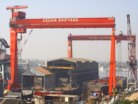 ET Bureau
ET BureauThe lessors’ stand has led to a change in strategy among airlines. Sources say the nation’s biggest carrier, IndiGo, will likely for the first time since its inception sign leasing contracts for periods longer than its usual six years. While the Wadia Group-controlled GoAir has for now stalled all plans for leasing additional planes, a senior executive at Air India said the national carrier is mulling outright purchase of remaining of the Boeing Dreamliner planes it has ordered, instead of going for a saleand-leaseback transaction.
Sale and leaseback — wherein an airline sells its plane to a lessor at a premium and leases it back — is a common strategy adopted by airlines to acquire aircraft.
 |
For IndiGo, the change means it will have a bulkier and more aged fleet. IndiGo has in the recent past placed two of the biggest passenger aircraft orders in aviation history —for 180 Airbus A320 planes in 2011 and another 250 last year. The airline’s strategy has been to maintain short contracts and keep replacing aircraft before they come up for heavy maintenance checks. The bulk orders give the airline the power to also wrest low lease rentals. All of this adds significantly to profits.
“With longer lease periods, IndiGo will be inundated with aircraft deliveries,” said a senior executive at a rival carrier. IndiGo currently has a fleet of 91 planes. However, the change comes at a time when IndiGo is on an aggressive expansion mode and so may not hurt the airline much.
“Also, the last five years have seen more than a 10% decrease in overall capacity in the Indian skies, thanks to Kingfisher Airlines’ demise and the more recent fleet cuts by SpiceJet. There is room for Indi-Go to maintain a bigger fleet. The increased revenue will make up for the hike in maintenance and other costs,” said an industry watcher who didn’t want to be named.
Air India has realised that buying is cheaper than leasing under the new conditions set by lessors. “For instance, for an Airbus A320, the principal plus interest for 12 years would be $400,000 a month, or a total of $57.6 million. If I take the plane on lease, I will have to pay the same rentals plus about $20 million on maintenance costs,” said the Air India executive.
The state-run airline has asked the government that it be allowed to purchase the nine Boeing 787 Dreamliner planes that are to be delivered in the next few years. The current 18 in its fleet are on sale and leaseback.
A longer lease contract works out well for the lessor due to multiple reasons. An aircraft usually goes for various maintenance checks, the most rigorous and costly being the D-check or the heavy maintenance check that happens after every seven years. A 10-year lease makes sure that the lessee airline has borne the expenses of all the maintenance checks within the lease period. In most cases, the airline has to keep a maintenance reserve for the checks.
If the heavy maintenance check has happened after seven years, the reserve for the remaining three years is transferred to the lessor which in turn is transferred to the next lessee.
For an Airbus A320 aircraft, the reserve investment would come to $100,000 per month, which means $3.6 million for three years. The Dcheck usually costs much more than the accumulated reserves during the seven years. The only flipside for the lessor is the lower monthly lease rentals as the contract is stretched over a longer period.
“So, if monthly lease rentals are 1% of the aircraft costs, the lessor will get 150% of what it paid at the end of the contract period,” said an Air India executive.
Indian airlines have lesser chance of convincing lessors to change their stance than their global peers as the lessors have been upset over various instances of default on monthly rentals.
The longer lease periods would have milder impact on airlines in the West where aircraft have greater longevity. For instance, the average age of the fleet of an American lowcost airline called Allegiant Air is 23 years. Air India has been under major criticism for keeping aircraft more than 10-years old in its fleet.
But in India, harsh environmental conditions have an adverse impact on the aircraft, especially engines. In India, the engine comes off after 3-4 years, instead of 6-7 years in the West, said an industry expert.
The replacement cost of the engine would be anywhere from $3 million for one powering a narrow-bodied aircraft, such as A320 and Boeing 737, to $7 million for the one in wide-bodied plane, like the A330, Boeing 777 and 747.
As far as engine health is concerned, “India is on par with the most challenging environments, such as China, Africa, and the Middle East,” said a spokeswoman for CFM International, an aircraft engine joint venture between GE Aviation of the US and France's Snecma.
Download The Economic Times News App to get Daily Market Updates & Live Business News.
Read More News on
Download The Economic Times News App to get Daily Market Updates & Live Business News.









 Get Unlimited Access to The Economic Times
Get Unlimited Access to The Economic Times
